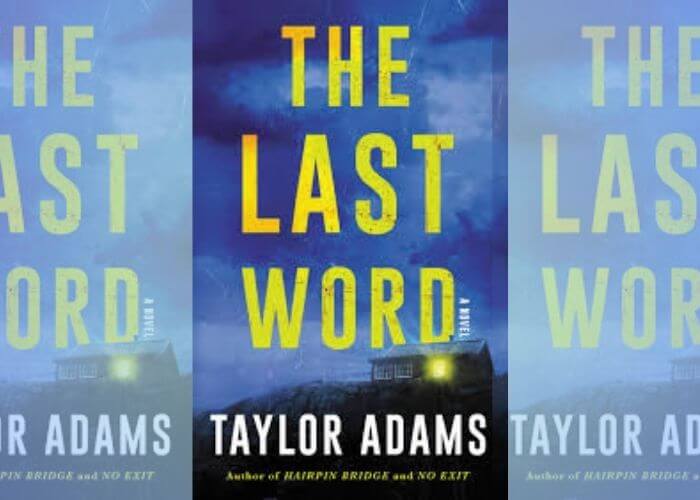Blog
The Last Word by Taylor Adams – Thriller Book Review

Introduction and Book Overview
The Last Word stands as another gripping entry in Taylor Adams‘ impressive catalog of psychological thrillers. This pulse-pounding novel of psychological suspense delivers exactly what readers expect from the critically acclaimed author of No Exit and Hairpin Bridge. The story centers around a book reviewer’s worst nightmare scenario, where a scathing one-star review spirals into a terrifying game of cat and mouse. Adams proves once again why he’s considered a master of psychological suspense and terror, crafting a narrative that keeps readers questioning reality until the very last word.
Plot Summary (Spoiler-Free)
The story follows Emma Carpenter, a former math teacher who lives in isolation at a remote beach house on the rainy Washington coast. Emma Carpenter lives in isolation with her golden retriever Laika, spending her days house-sitting and reading Kindle books. Her peaceful routine takes a dark turn when she posts a one-star review of what she considers a poorly written—but gruesome—horror novel by author H.G. Kane.
What begins as a standard book review quickly escalates when Kane responds via text to her negative review. The online argument transforms from professional disagreement to something far more sinister. Strange incidents begin occurring at the isolated beach house, and Emma realizes that her scathing review may have triggered something dangerous in this pulse-pounding novel.
The central mystery revolves around H.G.‘s true identity and how he discovered Emma’s location at the remote beach house. As the psychological thriller unfolds, Emma must navigate increasingly threatening situations while trying to understand her enigmatic old neighbor and the house’s owner‘s connection to the unfolding terror.
Character Analysis
Emma Carpenter reads voraciously and serves as a relatable protagonist for anyone who has ever felt strongly about a book. Her character development throughout the story shows genuine growth as she transitions from passive victim to active survivor. Living in isolation with her golden retriever, Emma’s initial vulnerability makes her subsequent empowerment all the more satisfying.
H.G. Kane emerges as a complex antagonist whose motivations run deeper than simple revenge over a bad review of a horror novel. The author’s psychological complexity drives much of the suspenseful read, making him more than just a typical slasher film villain. His characterization benefits from the book-within-a-book structure that Adams employs effectively.
Supporting characters, including Emma’s neighbor, recommended contacts, and various online personalities, serve their roles well without overwhelming the central conflict between Emma and Kane.
Writing Style and Structure
Adams’ trademark rapid-fire pacing keeps readers engaged from start to finish. The twisty narrative structure, featuring a story-within-a-story format, creates seamless transitions between Emma’s reality and the horror novel excerpts. This well-structured approach allows for many twists that feel organic rather than forced.
The atmosphere of the isolated beach setting creates a claustrophobic tension that serves the story perfectly. The remote location becomes almost a character itself, with the Washington state coastal environment adding to the overall sense of dread and isolation.
Themes and Social Commentary
The novel explores the complex relationship between authors and readers in the digital age. The power of book reviews to affect authors’ careers and mental states receives thoughtful examination. The story delves into online harassment and the sometimes dangerous consequences of digital interactions.
Living in a remote location serves as both literal and metaphorical isolation, exploring how physical separation can leave individuals vulnerable while also providing potential sanctuary. The psychological suspense elements examine the thin line between creative passion and obsession.
Strengths of the Novel
The plot twists and turns consistently surprise readers without feeling contrived. Adams demonstrates masterful suspense-building, creating genuine tension that kept me glued to the pages. The meta-fictional elements work particularly well, with the book within a book structure adding layers of meaning to the overall narrative.
The psychological depth of both the protagonist and antagonist elevates this beyond typical thrillers. Each character’s motivations feel authentic, making their actions believable within the story’s framework. This must-read quality comes from Adams’s ability to balance plot twists with character development.
Areas for Improvement
While generally strong, some readers might find certain plot twists stranger than fiction in their execution. The pacing occasionally rushes through moments that could benefit from more development, particularly in the final act, where resolution comes quickly after sustained tension.
Some secondary character interactions feel underdeveloped, though this doesn’t significantly detract from the overall reading experience. The edge-of-your-seat excitement remains consistent throughout most of the narrative.
Comparison to Other Works
Compared to No Exit and Hairpin Bridge, The Last Word shows Adams’ continued evolution as a thriller writer. While maintaining his signature pulse-pounding style, this novel demonstrates greater psychological complexity than his earlier works. The crime fiction elements blend seamlessly with psychological thriller conventions.
Within the broader thriller genre, this book stands alongside other excellent works exploring digital-age harassment and author psychology. The psychological suspense elements compare favorably to works by authors like Gillian Flynn and Ruth Ware.
Target Audience and Recommendations
This Taylor Adams book will appeal strongly to thriller enthusiasts and fans of psychological suspense. Readers who enjoyed his previous works will find this a worthy addition to his catalog. The suspenseful read quality makes it perfect for those seeking pulse-pounding entertainment.
Content warnings include psychological manipulation, stalking, and some violence. The reading experience provides intense emotional engagement without relying on excessive gore or graphic content. Anyone who spends her days reading will particularly appreciate the insider perspective on book culture.
Final Assessment
The Last Word by Taylor Adams earns a solid four-star rating for its effective blend of psychological thriller elements and contemporary social commentary. The excellent review it deserves comes from its ability to keep readers glued to the pages while delivering meaningful themes about digital communication and creative obsession.
This favorite book’s potential comes from Adams’ skillful handling of familiar thriller tropes in fresh ways. The memorable elements include the innovative book within a book structure and the genuinely surprising plot twists that don’t feel forced or manipulative.
The clear recommendation is to read this book, especially for fans of psychological suspense. It’s a page-turner that justifies its place among contemporary thrillers while offering unique insights into modern author-reader relationships.
Additional Notes
The Last Word is available in multiple formats, including e-reader options, making it accessible to various reading preferences. As a standalone novel, it doesn’t require familiarity with Adams’ previous works, though fans of Exit and Hairpin Bridge will notice his continued stylistic evolution.
Taylor Adams continues to establish himself as a significant voice in contemporary thriller writing, with this latest work demonstrating his ability to tackle current social issues through the lens of psychological suspense. The critically acclaimed author shows no signs of slowing down in delivering quality, suspenseful reads that resonate with modern audiences.
